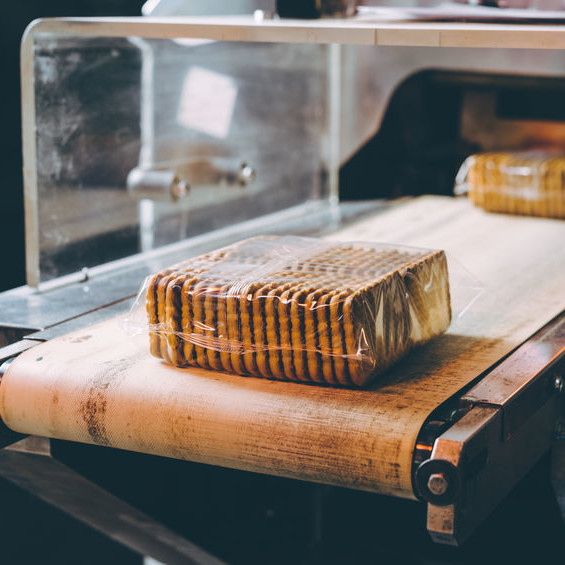
Hygienic Design of Belt Conveyors
What is the Hygienic Design of Belt Conveyors?
Belt conveyors are an essential component of industrial bakeries. They allow work-in-progress and finished products to effectively move along the production line. The hygienic design of belt conveyors encompasses the hygienic principles, strategies and engineering considerations that must be applied in the design phase of a conveyor so that it does not become a contamination source for the food products handled in the production line.
Prevention of biological, physical and chemical hazards that may originate from the equipment is key when designing and constructing belt conveyors.
How does it work?
Belt conveyors in high-speed bakeries come into direct contact with foods and perform the following functions:
- Bulk transport of dough from mixer to makeup equipment
- Discrete transport of divided dough pieces along makeup stage
- Discrete transport of baked and depaned bread loaves and buns
Strategy for the hygienic design of belt conveyors
Belt conveyors are designed based on the following criteria:
- Level of overall plant hygiene required according to food safety risks for raw materials and finished products.
- Characteristics of the products that will be processed, e.g. moisture content, microbial stability, dough consistency.
- HACCP plan and preliminary hazard analysis.
- Type and nature of plant operations.
Principles / guidelines for hygienic design of belt conveyors:1,2
- Equipment should be accessible for inspection and maintenance. It is crucial to enable easy access to all parts. Additional features such as belt lifters should be installed to ensure that wear strips and other components of the conveyor are cleaned thoroughly.
- Equipment should be easy to dismantle or disassemble with normal tools for cleaning and maintenance purposes.
- Equipment should be easy to clean and sanitize to minimize the risk of various food safety hazards.
- Conveyor belts should be drainable for wet cleaning purposes. All horizontal surfaces that create dead points should be reduced to a minimum and should have a 3° of inclination to allow water to run off. Accumulation of soil, dusting flour and cleaning solutions around the edges of belt and framework must be avoided.
- Belt materials should be made with tension resistant, non-porous, water-tight and non-absorbent fabrics and materials to prevent microbial growth and contamination.
- Belt fabrics and materials should be smooth, continuous and free from cracks, crevices, scratches and pits that may harbour and retain soil and/or microorganisms after cleaning.
- To avoid any hygiene risk, drives of belts and any appendages such as sensors must be covered, and the belt should be clear of framework to give open access to the belt and rollers for cleaning.
Application1,2
- Cracks and crevices on belt surfaces can be caused by aging or tension in the belt (friction driven).
- Belts containing multiple layers of fabrics may become a potential harborage point for bacteria. Once microorganisms colonize the inner fabric of belt, it will be impossible to remove or kill without destroying the belt itself.
- Bakeries should always establish specifications for machine manufacturers when buying new equipment. This should be part of the hygienic design prerequisite program.
- If friction-driven crevices or cracks on belt surfaces cannot be eliminated, then preventive measures to replace flat belts should be taken as soon as cracks or crevices are visible. Retrofitting belt into a zero-tension belt technology is highly recommended.
- Modular plastic belts are not recommended for dough conveyors. This type of belts uses hinges that create dead areas (very small apertures) that cannot be cleaned easily and thoroughly.
- Open plastic modular belts tend to be more difficult to clean, in particular because of the crevice between the connecting rods and the belt. Newer designs use oblong openings for round rods, creating enough room for cleaning.
- All belting should be easily removable so that surfaces underneath can be cleaned.
- Belt tension should be adequate throughout conveyor operation to prevent water from pooling on the belt surface.
- All rotating and mechanical components of belt (e.g. drive sprockets, belt pulleys) should be solid (or filled with dye) and fully sealed with continuous welding techniques.
- Using an angled profile is beneficial in preventing product debris from staying inside food processing equipment after cleaning.
References
- Lelieveld, H.L.M.. “Hygienic Design of Food Processing Equipment.” Hygiene in Food Processing: Principles and Practice, 2nd edition, Woodhead Publishing Limited, 2014, pp. 91–130.
- Kold, J., and Silverman, C. “Conveyors Used in the Food Industry.” Handbook of Hygiene Control in the Food Industry, 2nd edition, Woodhead Publishing, Elsevier Ltd., 2016, pp. 367–382.

